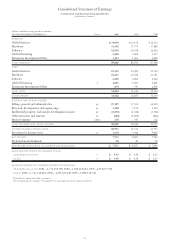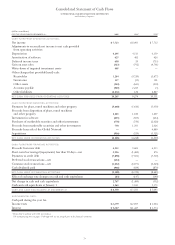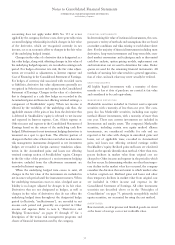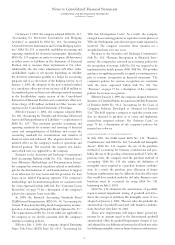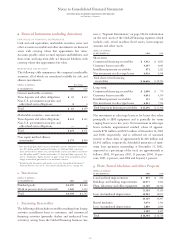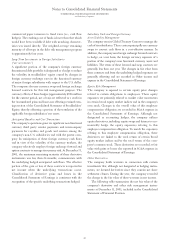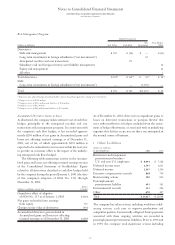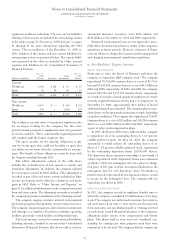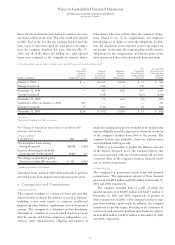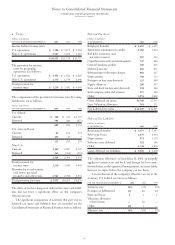IBM 2001 Annual Report Download - page 82
Download and view the complete annual report
Please find page 82 of the 2001 IBM annual report below. You can navigate through the pages in the report by either clicking on the pages listed below, or by using the keyword search tool below to find specific information within the annual report.
Notes to Consolidated Financial Statements
INTERNATIONAL BUSINESS MACHINES CORPORATION
and Subsidiary Companies
80
On January 1, 2001, the company adopted SFAS No. 133,
“Accounting for Derivative Instruments and Hedging
Activities,” as amended by SFAS No. 138, “Accounting for
Certain Derivative Instruments and Certain Hedging Activi-
ties.” SFAS No. 133, as amended, establishes accounting and
reporting standards for derivative instruments. Specifically,
SFAS No. 133 requires an entity to recognize all derivatives
as either assets or liabilities in the Statement of Financial
Position and to measure those instruments at fair value.
Additionally, the fair value adjustments will affect either
stockholders’ equity or net income depending on whether
the derivative instrument qualifies as a hedge for accounting
purposes and, if so, the nature of the hedging activity. As of
January 1, 2001, the adoption of the new standard resulted
in a cumulative effect net-of-tax increase of $219 million to
Accumulated gains and losses not affecting retained earnings
in the Stockholders’ equity section of the Consolidated
Statement of Financial Position and a cumulative effect net-
of-tax charge of $6 million included in Other income and
expense in the Consolidated Statement of Earnings.
Effective January 1, 2001, the company adopted SFAS
No. 140, “Accounting for Transfers and Servicing of Financial
Assets and Extinguishments of Liabilities
—
a replacement of
SFAS No. 125.” This statement provides accounting and
reporting standards for transfers and servicing of financial
assets and extinguishments of liabilities and revises the
accounting standards for securitizations and transfers of
financial assets and collateral. The adoption did not have a
material effect on the company’s results of operations and
financial position. The standard also requires new disclo-
sures which were not applicable to the company.
Pursuant to the Securities and Exchange Commission’s
Staff Accounting Bulletin (SAB) No. 102, “Selected Loan
Loss Allowance Methodology and Documentation Issues,”
the company has reviewed its policies related to methodolo-
gies for the determination of, and documentation in support
of its allowance for loan losses and the provision for loan
losses in its Global Financing segment. The company’s
methodology and documentation policies are consistent with
the views expressed within SAB 102. See “Customer Loans
Receivable,” on page 79 for a description of the company’s
policies for customer loans receivable.
In 2000, the Financial Accounting Standards Board
(FASB) issued Interpretation (FIN) No. 44, “Accounting for
Certain Transactions Involving Stock Compensation, an inter-
pretation of Accounting Principles Board Opinion No. 25.”
The requirements of FIN No. 44 are either not applicable to
the company or are already consistent with the company’s
existing accounting policies.
Effective July 1, 2000, the company adopted Emerging
Issues Task Force (EITF) Issue No. 00-2, “Accounting for
Web Site Development Costs.” As a result, the company
changed its accounting policies to capitalize certain phases of
Web site development costs that were previously expensed as
incurred. The company amortizes these amounts on a
straight-line basis over two years.
Pursuant to the Securities and Exchange Commission’s
SAB No. 101, “Revenue Recognition in Financial State-
ments,” the company has reviewed its accounting policies for
the recognition of revenue. SAB No. 101 was required to be
implemented in fourth quarter 2000. SAB No. 101 provides
guidance on applying generally accepted accounting princi-
ples to revenue recognition in financial statements. The
company’s policies for revenue recognition are consistent
with the views expressed within SAB No. 101. See
“Revenue,” on page 75 for a description of the company’s
policies for revenue recognition.
Effective January 1, 1999, the company adopted American
Institute of Certified Public Accountants (AICPA) Statement
of Position (SOP) No. 98-1, “Accounting for the Costs of
Computer Software Developed or Obtained for Internal
Use.” The SOP requires a company to capitalize certain costs
that are incurred to purchase or to create and implement
internal-use computer software. See “Software Costs,” on
page 79 for a description of the company’s policies for
internal-use software.
NEW STANDARDS TO BE IMPLEMENTED
In July 2001, the FASB issued SFAS No. 141, “Business
Combinations,” and SFAS No. 142,“Goodwill and Intangible
Assets.” SFAS No. 141 requires the use of the purchase
method of accounting for business combinations and pro-
hibits the use of the pooling of interests method. Under the
previous rules, the company used the purchase method of
accounting. SFAS No. 141 also refines the definition of
intangible assets acquired in a purchase business combina-
tion. As a result, the purchase price allocation of future
business combinations may be different than the allocation
that would have resulted under the old rules. Business com-
binations must be accounted for using SFAS No. 141
beginning on July 1, 2001.
SFAS No. 142 eliminates the amortization of goodwill,
requires annual impairment testing of goodwill and intro-
duces the concept of indefinite life intangible assets. It was
adopted on January 1, 2002. The new rules also prohibit the
amortization of goodwill associated with business combina-
tions that close after June 30, 2001.
These new requirements will impact future period net
income by an amount equal to the discontinued goodwill
amortization offset by goodwill impairment charges, if any,
and adjusted for any differences between the old and new rules
for defining intangible assets on future business combinations.


